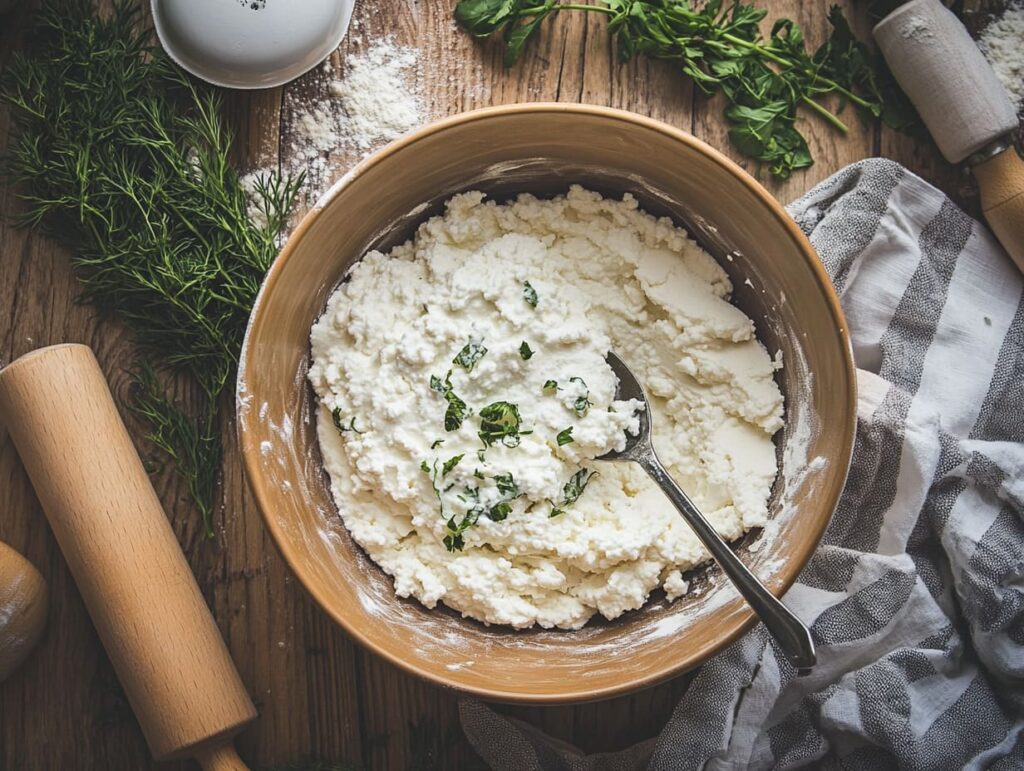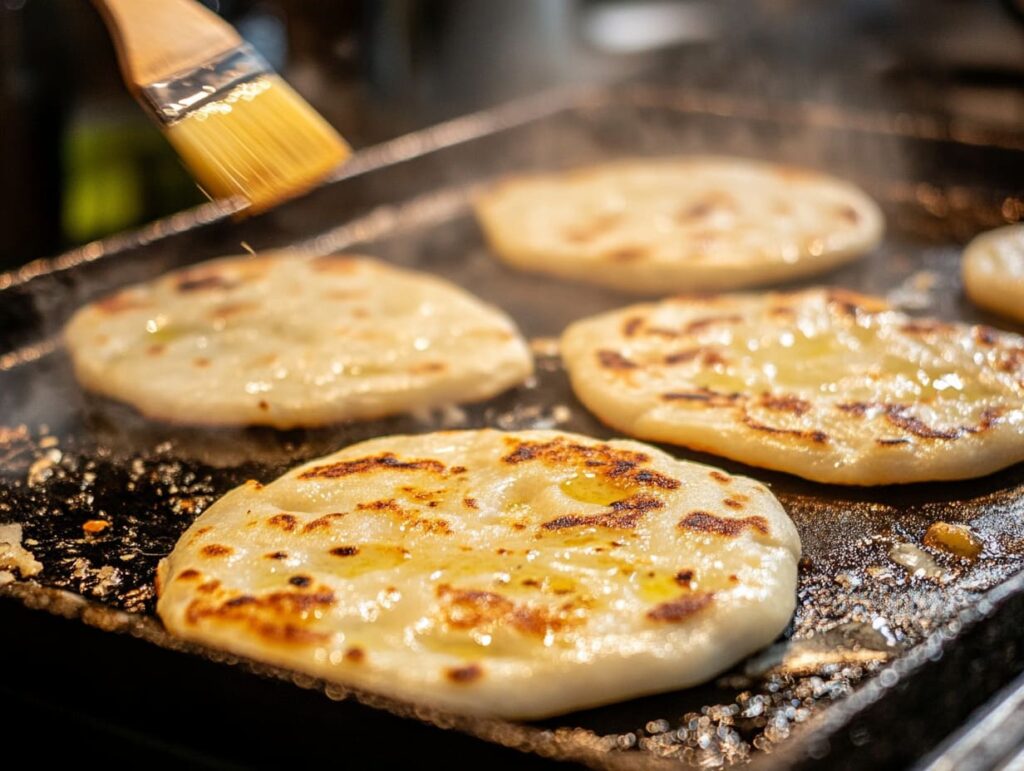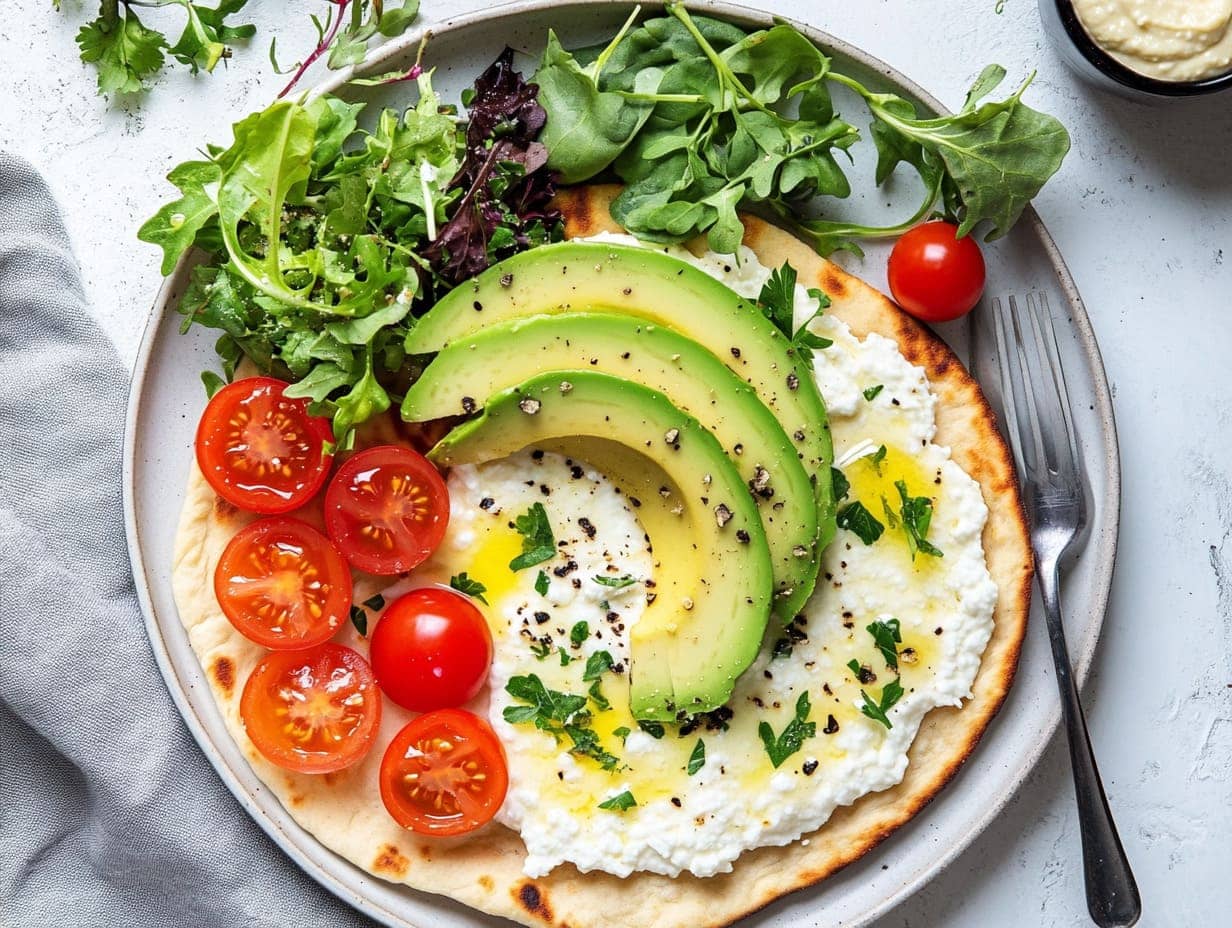Cottage cheese flatbread is a delicious, versatile, and nutritious dish that combines the creamy texture of cottage cheese with the satisfying heartiness of homemade flatbread. This recipe stands out for its simplicity, making it perfect for both seasoned cooks and kitchen beginners. Whether enjoyed as a quick snack, paired with soups and salads, or used as a base for creative toppings, cottage cheese flatbread offers endless possibilities.
Flatbreads have been a staple across cultures for centuries, and adding cottage cheese to the mix elevates their flavor and nutritional profile. With its high protein content, calcium, and creamy tang, cottage cheese enhances the bread’s texture while making it more filling and nutritious. Plus, it’s a great way to incorporate a beloved dairy product into your diet.
This article explores the steps to make cottage cheese flatbread, serving suggestions, variations, and storage tips to help you master this versatile recipe.
Benefits of Cottage Cheese
1. Rich in Protein
Cottage cheese is a high-protein food, making it ideal for flatbread recipes. Protein helps maintain muscles and keeps you feeling full longer.
2. Low in Calories
Despite its creamy texture, cottage cheese is low in calories. This makes it an excellent option for those watching their weight.
3. Enhances Texture
When added to dough, cottage cheese creates soft and fluffy flatbreads. Its mild tangy flavor complements a variety of toppings and dips.
4. Calcium for Bone Health
As a dairy product, cottage cheese is a fantastic source of calcium. Calcium is essential for strong bones and healthy teeth.
Essential Ingredients for Cottage Cheese Flatbread

- 1 cup cottage cheese
- Use full-fat or low-fat based on preference. Ensure it is well-drained.
- 1 ½ cups all-purpose flour
- Substitute with whole wheat or gluten-free flour as needed.
- 1 teaspoon baking powder
- Ensure it’s fresh for the best results.
- ½ teaspoon salt
- Adjust based on the saltiness of your cottage cheese.
- 2 tablespoons olive oil or melted butter
- Optional for added richness and a golden finish.
Optional Add-Ins for Flavor
- ½ teaspoon garlic powder
- 1 teaspoon dried oregano or fresh parsley
- 1 tablespoon sesame or poppy seeds
Step-by-Step Recipe for Cottage Cheese Flatbread

1. Preparation
- Gather all ingredients: cottage cheese, flour, baking powder, salt, and optional add-ins.
- Drain the cottage cheese to avoid excess moisture.
- Preheat a non-stick skillet or griddle over medium heat for cooking.
2. Mixing the Dough
- Combine the following in a large mixing bowl:
- 1 cup cottage cheese (well-drained).
- 1 ½ cups all-purpose flour.
- 1 teaspoon baking powder.
- ½ teaspoon salt.
- (Optional) 2 tablespoons olive oil or melted butter for extra flavor.
- Mix the ingredients using a spoon or your hands until the dough comes together in a soft, sticky ball.
3. Kneading the Dough
- Transfer the dough to a floured surface.
- Knead for about 5–7 minutes until the dough becomes smooth and elastic.
- Sprinkle small amounts of flour as needed to prevent sticking. Avoid adding too much to maintain softness.
4. Dividing and Shaping
- Divide the dough into 4–6 equal portions, depending on your desired flatbread size.
- Roll each portion into a small ball.
- Flatten the balls using a rolling pin to create rounds or ovals about ¼ inch thick.
5. Cooking the Flatbread
- Place one dough piece onto the preheated skillet or griddle.
- Cook for 2–3 minutes on one side until bubbles form and golden-brown spots appear.
- Flip the flatbread and cook for another 2–3 minutes on the other side.
- (Optional) Brush the cooked side with olive oil or butter for a golden finish.
6. Serving Warm
- Once cooked, remove the flatbread from the skillet and let it cool for a minute.
- Serve warm with dips, spreads, or as a side to your favorite dishes.
Serving Suggestions for Cottage Cheese Flatbread
Cottage cheese flatbread is an incredibly versatile dish, making it a perfect addition to a wide range of meals. Whether you’re looking for a quick snack, a creative side, or a hearty main, this flatbread can do it all. Here are some exciting ways to serve it:
1. Pair with Dips and Spreads
To start, flatbread is fantastic with dips and spreads. For instance, pair it with creamy hummus, tangy tzatziki, or rich guacamole. Additionally, try spreading cream cheese, flavored butter, or garlic aioli for an effortless yet tasty treat. If you prefer something tangy, serve it alongside marinara sauce or spicy tomato chutney for a bold flavor boost.
2. Transform It into Topped Flatbreads
Flatbreads make an excellent base for toppings, allowing you to get creative. For a vegetarian option, consider sautéed spinach, earthy mushrooms, and a sprinkle of feta cheese. Alternatively, try a Mediterranean twist with sliced olives, sun-dried tomatoes, and crumbled goat cheese. If you’re making breakfast, you can’t go wrong with avocado, scrambled eggs, and a dash of chili flakes.
3. Serve It with Soups and Salads
Another way to enjoy cottage cheese flatbread is by pairing it with comforting soups or refreshing salads. For example, serve it alongside tomato basil soup, lentil stew, or creamy broccoli soup to create a cozy meal. Moreover, it complements salads like Greek salad, Caesar salad, or even a light arugula and citrus mix beautifully.
4. Use It as a Wrap or Sandwich Base
For a more substantial meal, use the flatbread as a wrap. Wrap grilled chicken, flavorful falafel, or roasted vegetables for a satisfying dish. Furthermore, you can create sandwiches by layering deli meats, cheeses, and fresh greens between two flatbreads for a quick lunch or dinner option.
5. Explore Sweet Options
Flatbread doesn’t have to be savory—it can be sweet too! For a healthier treat, drizzle it with honey and top it with fresh fruits such as strawberries, blueberries, or figs. You could also spread almond or peanut butter, then sprinkle chia seeds for a nutritious snack. Lastly, for dessert, brush it with melted butter, sprinkle with cinnamon and sugar, and enjoy!
6. Add It to a Charcuterie Board
Flatbread also works wonderfully on charcuterie boards. For example, you can pair it with an assortment of cheeses, cured meats, and pickles to create a sharing platter that’s both delicious and visually appealing.
7. Keep It Simple
Finally, sometimes simplicity is best. Serve the flatbread plain, or lightly brush it with olive oil and sprinkle sea salt or herbs for a minimalist, yet delightful, flavor.
Variations of Cottage Cheese Flatbread
Cottage cheese flatbread is not only delicious but also incredibly versatile. By tweaking the recipe, you can adapt it to suit various dietary needs and flavor preferences. Here are some exciting variations to try:
Gluten-Free Cottage Cheese Flatbread
If you need a gluten-free option, substitute all-purpose flour with a gluten-free flour blend. Be sure to use a mix that includes xanthan gum for elasticity. Almond flour or chickpea flour also works well, offering unique flavors and added protein. Adjust the amount slightly since gluten-free flours absorb liquid differently.
Vegan Cottage Cheese Flatbread
For a vegan version, replace the cottage cheese with a plant-based alternative like almond or cashew cheese. You can also use mashed tofu blended with a bit of lemon juice to mimic the tanginess of cottage cheese. Swap olive oil or melted butter with coconut oil or another vegan-friendly fat.
Herb-Infused Flatbread
Enhance the flavor by adding fresh or dried herbs to the dough. For instance, mix in chopped parsley, rosemary, thyme, or dill. Garlic powder or onion powder also makes an excellent addition for a savory kick. Herb-infused flatbreads pair wonderfully with soups, salads, or cheese boards.
Cheese-Stuffed Flatbread
Take it up a notch by stuffing the flatbread with cheese. Roll out the dough, spread a thin layer of shredded mozzarella or cheddar, then fold and seal the edges. Roll it out again gently before cooking. The result is a gooey, cheesy flatbread that’s perfect for dipping.
Spicy Flatbread
For a spicy twist, add crushed red pepper flakes, chili powder, or finely chopped jalapeños to the dough. This variation is ideal for serving with cooling dips like tzatziki or a creamy avocado spread.
Sweet Cottage Cheese Flatbread
Turn your flatbread into a sweet treat by mixing a teaspoon of sugar and a dash of cinnamon into the dough. Once cooked, drizzle the flatbread with honey or maple syrup, then top with fresh fruits, nuts, or even a dollop of yogurt for a delightful dessert.
Seeded Flatbread
Incorporate seeds like sesame, flax, chia, or poppy seeds directly into the dough for added crunch and nutrition. You can also sprinkle seeds on top of the flatbread before cooking for a decorative and flavorful touch.
These variations showcase just how adaptable cottage cheese flatbread can be. With a little creativity, you can tailor it to match any meal or occasion.
If you love experimenting other unique flavor profiles :
How to Make the Best Pickle Pie Pizza Recipe at Home
Southern Cornbread Recipe: Crispy, Golden, and Easy to Make
Frequently Asked Questions (FAQs)
1. Can I use low-fat or fat-free cottage cheese for this recipe?
Yes, low-fat or fat-free cottage cheese works well in this recipe. However, using full-fat cottage cheese adds more richness and flavor to the flatbread. If you opt for low-fat, you may need to adjust the moisture content by draining it thoroughly.
2. What is the best way to store leftover cottage cheese flatbread?
To store leftovers, allow the flatbread to cool completely. Place it in an airtight container or wrap it tightly in plastic wrap. Store it in the refrigerator for up to 3 days. For longer storage, freeze the flatbreads in a zip-top bag for up to 3 months. Reheat them in a skillet or oven for the best texture.
3. Can I make the dough ahead of time?
Yes, you can prepare the dough in advance. Wrap the dough tightly in plastic wrap and refrigerate it for up to 24 hours. When ready to use, let it sit at room temperature for 15–20 minutes before rolling and cooking.
4. Can I bake the flatbread instead of cooking it on a skillet?
Absolutely! To bake the flatbread, preheat your oven to 375°F (190°C). Place the rolled-out dough on a parchment-lined baking sheet. Bake for 8–10 minutes, flipping halfway through, until golden brown.
5. Can I make this recipe gluten-free?
Yes, substitute all-purpose flour with a gluten-free flour blend or almond flour. Ensure the substitute contains a binding agent like xanthan gum for proper texture. Keep in mind that the dough’s consistency may vary slightly, so adjust the liquid or flour as needed.
6. What can I use as a substitute for cottage cheese?
If you don’t have cottage cheese, you can use ricotta cheese as a substitute. Greek yogurt is another good alternative, though it may slightly alter the texture and flavor.
7. How can I make the flatbread more flavorful?
To enhance the flavor, add herbs like rosemary or parsley, spices like garlic powder, or even grated cheese to the dough. You can also brush the cooked flatbread with melted butter or olive oil and sprinkle it with sea salt or sesame seeds.
Conclusion
Cottage cheese flatbread is a simple yet versatile recipe that perfectly balances nutrition, flavor, and texture. Whether you’re looking for a quick snack, a side dish, or a creative base for your favorite toppings, this flatbread has you covered. The creamy richness of cottage cheese not only enhances the bread’s softness but also boosts its nutritional value, making it a healthier choice for any meal.
With countless variations and serving ideas, this recipe is adaptable to suit any occasion or dietary preference. From gluten-free to vegan options, or even sweet and spicy twists, there’s a version of cottage cheese flatbread for everyone. Plus, with proper storage and reheating tips, you can enjoy leftovers just as fresh as the first batch.
So why wait? Gather your ingredients, follow the step-by-step guide, and whip up a batch of cottage cheese flatbread today. Your taste buds—and those of your family or guests—will thank you!
If you’d like further adjustments or additional sections, let me know!

